John Johnson (1777-1848) operated Sir Samuel Egerton Brydges's Lee Priory Press before a falling-out. Typographia was printed at his Apollo Press, in Brook Street, Holborn, with the financial support of Edward Walmsley, and came out in four sizes. "Of the few standard works on the art of printing in the English language, this is perhaps the most familiar. [The first volume contains] a table of the introduction of the art into the different countries, after which comes the "introduction and art in Great Britain", with a list of the productions of the first printers up to 1599. The second volume may be described as practical, in contradistinction to the first, which is historical. It gives a description of types, directions for composing, for press, and warehouse work, &c. It is particularly rich in foreign alphabets, a feature which has gained of it great estimation. It has long since become, and deservedly, a printer's classic" - Bigmore & Wyman, I, pp.371-2.Note: This is the book that served as a source of plagiarism for Adams's Typographia: a brief sketch of the origin, rise, and progress of the typographic art published in Philadelphia by himself in 1837. The copy returned to the seller for the reason stated in section Points above and replaced with the unaltered copy LIB-2693.2021.
-
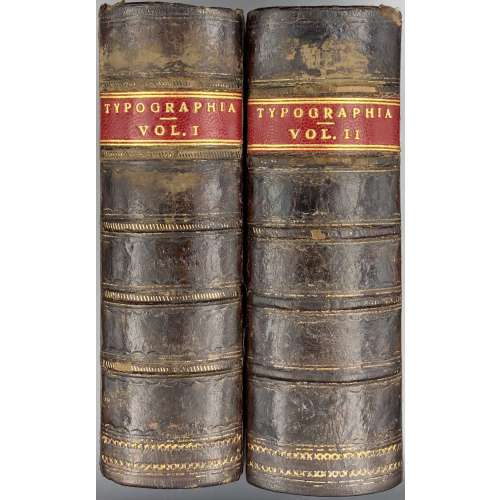 2 volume set. Vol. 1. Title: Typographia, | OR THE | Printers' Instructor : | INCLUDING AN ACCOUNT | of the | ORIGIN OF PRINTING, | with | Biographical Notices of the Printers of | England, from Caxton to the close | of the Sixteenth Century : | A Series of | Ancient and Modern Alphabets, | and | DOMESDAY CHARACTERS : | Together with | An Elucidation of every Subject con- | nected with the Art. | By J. JOHNSON, Printer. |{stanza}| Vol. I. | In frame: Published by Messrs. Longman, Hurst, | Rees, Orme, Brown & Green, Pater- | noster Row, London | Under the frame: 1824. || Typographical frame with the names of distinguished printers; on the cornerstone: William Caxton, 1474. Pagination: ffl / blank, blank / engraved frontis., engraved t.p. / blank, engraved dedication / list of club members, engraved arms vignette / blank, [4] pedigree, [i] ii-xii – preface, [1] 2-610, [10] – index, bfl. Text printed in the frame. To ffl : previous owner’s inscription: Herbert Heath | from | William Blades. | Xmas 1886; Frontispiece: Portrait of John Johnson at age 46, engraved on wood by W. Hughes; t.p.: TYPOGRAPHIA, | OR THE | PRINTERS INSTRUCTOR | BY | J.JOHNSON | PRINTER. VOL. 2. | 1824 | frame with lettering, top: GUTTnbg – FAUST – ELZEVIR – ALDUS, bottom: MENTZ – STRASbg –HARLAEM | below: BIBLIOTHECA • BODLEIANA. | below the frame: G.W.BONNER SC ||; Dedication to Earl Spenser, K. G., and the members of The Roxburghe Club, dated 1824, engraved on wood by W. Hughes; Arms vignette: Roxburghe Club | Instituted | June XVII | M D CCCXII || engraved on wood by William Harvey. Provenance: Admiral Sir Herbert Leopold Heath, KCB MVO (1861 – 1954); William Blades (1824 – 1890) – English printer and bibliographies. Inscription to ffl in both vols:D. Bateman. Vol. 2. Pagination: ffl, t.p. (similar lettering, but Vol. II.) / blank, [2] advert., [i] ii-iv contents, [1, 2] 3-663 [664] [16]. Points: Vol. 1.: Frontispiece portrait of Caxton replaced by a portrait of J. Johnson from Vol. 2, engraved t.p. of Vol. 1. replaced by t.p. of Vol. 2; Vol. 2 without engraved t.p., and without frontispiece. Edition: First Edition. Size: 16mo. 12.5 x 8.5 cm Binding: Mid-nineteenth century polished calf, the covers with a border of a gilt double fillet and blind roll. Spine divided into six panels with raised bands flanked with gilt fillets, lettered on new red goatskin labels, marbled endleaves and edges. Seller's description:
2 volume set. Vol. 1. Title: Typographia, | OR THE | Printers' Instructor : | INCLUDING AN ACCOUNT | of the | ORIGIN OF PRINTING, | with | Biographical Notices of the Printers of | England, from Caxton to the close | of the Sixteenth Century : | A Series of | Ancient and Modern Alphabets, | and | DOMESDAY CHARACTERS : | Together with | An Elucidation of every Subject con- | nected with the Art. | By J. JOHNSON, Printer. |{stanza}| Vol. I. | In frame: Published by Messrs. Longman, Hurst, | Rees, Orme, Brown & Green, Pater- | noster Row, London | Under the frame: 1824. || Typographical frame with the names of distinguished printers; on the cornerstone: William Caxton, 1474. Pagination: ffl / blank, blank / engraved frontis., engraved t.p. / blank, engraved dedication / list of club members, engraved arms vignette / blank, [4] pedigree, [i] ii-xii – preface, [1] 2-610, [10] – index, bfl. Text printed in the frame. To ffl : previous owner’s inscription: Herbert Heath | from | William Blades. | Xmas 1886; Frontispiece: Portrait of John Johnson at age 46, engraved on wood by W. Hughes; t.p.: TYPOGRAPHIA, | OR THE | PRINTERS INSTRUCTOR | BY | J.JOHNSON | PRINTER. VOL. 2. | 1824 | frame with lettering, top: GUTTnbg – FAUST – ELZEVIR – ALDUS, bottom: MENTZ – STRASbg –HARLAEM | below: BIBLIOTHECA • BODLEIANA. | below the frame: G.W.BONNER SC ||; Dedication to Earl Spenser, K. G., and the members of The Roxburghe Club, dated 1824, engraved on wood by W. Hughes; Arms vignette: Roxburghe Club | Instituted | June XVII | M D CCCXII || engraved on wood by William Harvey. Provenance: Admiral Sir Herbert Leopold Heath, KCB MVO (1861 – 1954); William Blades (1824 – 1890) – English printer and bibliographies. Inscription to ffl in both vols:D. Bateman. Vol. 2. Pagination: ffl, t.p. (similar lettering, but Vol. II.) / blank, [2] advert., [i] ii-iv contents, [1, 2] 3-663 [664] [16]. Points: Vol. 1.: Frontispiece portrait of Caxton replaced by a portrait of J. Johnson from Vol. 2, engraved t.p. of Vol. 1. replaced by t.p. of Vol. 2; Vol. 2 without engraved t.p., and without frontispiece. Edition: First Edition. Size: 16mo. 12.5 x 8.5 cm Binding: Mid-nineteenth century polished calf, the covers with a border of a gilt double fillet and blind roll. Spine divided into six panels with raised bands flanked with gilt fillets, lettered on new red goatskin labels, marbled endleaves and edges. Seller's description: -
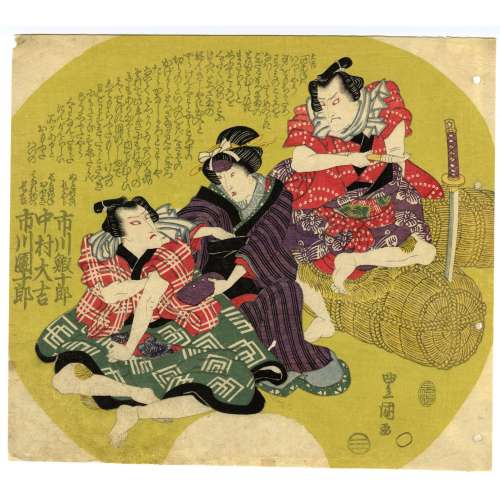 Artist: Utagawa Toyokuni I [歌川豊国] (1769–1825). Publisher: Ibaya Senzaburō [伊場屋 仙三郎] (fl. 1815 – 1869). Signed: Toyokuni ga [豊国 画]. Publisher's seal: Ibaya Sensaburō (Marks 08-067 | 127b). Date-aratame seal: Bunsei 3 (1820). Size: Uncut fan print (uchiwa-e), 224 x 254 mm. Ichikawa Ebijūrō I as Nuregami Chōgorō [濡髪の長五郎], Nakamura Daikichi as Hanaregoma Oseki [放駒のお関], and Ichikawa Danjūrō VII as Hanaregoma Chōkichi [放駒長吉] in a kabuki play Futatsu Chôchô Kuruwa Nikki [双蝶々曲輪日記] (A Diary of Two Butterflies in the Pleasure Quarters (see: LIB-0879.2015 | Brandon, James R., Leiter, Samuel L. Kabuki Plays on Stage: Brilliance and Bravado, 1697-1766 (Volume 1). — Honolulu: University of Hawai'i Press, 2002.) The play was performed at Kawarasakiza (Edo) in May of 1820. Actors: Ichikawa Ebijūrō I [市川鰕十郎] (Japanese, 1777 – 1827); other names: Ichikawa Ichizō I [市川市蔵], Ichinokawa Ichizō [市ノ川市蔵]. Nakamura Daikichi I [初代中村大吉](Japanese, 1773 – 1823); other names: Fujikawa Daikichi [藤川大吉]; poetry name Hajō [巴丈]; pen name Naruo Yatarō [藤川大吉]. Ichikawa Danjūrō VII 市川団十郎 (Japanese, 1791 – 1859); other names: Ichikawa Ebizō V, Ichikawa Hakuen II, Ichikawa Shinnosuke I.
Artist: Utagawa Toyokuni I [歌川豊国] (1769–1825). Publisher: Ibaya Senzaburō [伊場屋 仙三郎] (fl. 1815 – 1869). Signed: Toyokuni ga [豊国 画]. Publisher's seal: Ibaya Sensaburō (Marks 08-067 | 127b). Date-aratame seal: Bunsei 3 (1820). Size: Uncut fan print (uchiwa-e), 224 x 254 mm. Ichikawa Ebijūrō I as Nuregami Chōgorō [濡髪の長五郎], Nakamura Daikichi as Hanaregoma Oseki [放駒のお関], and Ichikawa Danjūrō VII as Hanaregoma Chōkichi [放駒長吉] in a kabuki play Futatsu Chôchô Kuruwa Nikki [双蝶々曲輪日記] (A Diary of Two Butterflies in the Pleasure Quarters (see: LIB-0879.2015 | Brandon, James R., Leiter, Samuel L. Kabuki Plays on Stage: Brilliance and Bravado, 1697-1766 (Volume 1). — Honolulu: University of Hawai'i Press, 2002.) The play was performed at Kawarasakiza (Edo) in May of 1820. Actors: Ichikawa Ebijūrō I [市川鰕十郎] (Japanese, 1777 – 1827); other names: Ichikawa Ichizō I [市川市蔵], Ichinokawa Ichizō [市ノ川市蔵]. Nakamura Daikichi I [初代中村大吉](Japanese, 1773 – 1823); other names: Fujikawa Daikichi [藤川大吉]; poetry name Hajō [巴丈]; pen name Naruo Yatarō [藤川大吉]. Ichikawa Danjūrō VII 市川団十郎 (Japanese, 1791 – 1859); other names: Ichikawa Ebizō V, Ichikawa Hakuen II, Ichikawa Shinnosuke I. -
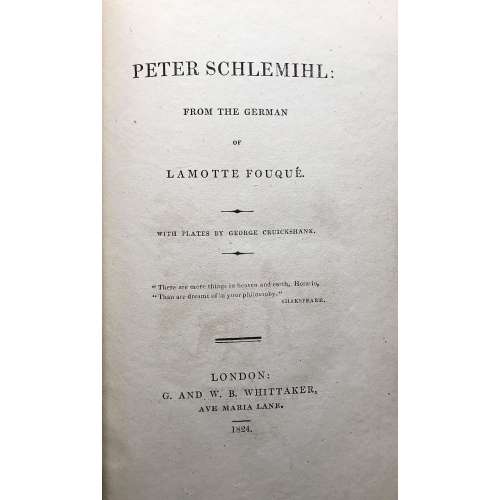 Title: PETER SCHLEMIHL: | FROM THE GERMAN | OF LAMOTTE FOUQUÉ | WITH PLATES BY GEORGE CRUICKSHANK. | "There are more things in heaven and earth, Horatio, | "Than are dreamt of in your philosophy." | SHAKESPEARE. | — | LONDON: | G. AND W. B. WHITTAKER, | AVE MARIA LANE. | 1824.|| Pagination: xii, 165 p. : ill. No Adelbert von Chamisso (German, 1781 – 1838) name on the title page. George Cruikshank's name printed with a typo 'Cruickshank'. The attribution on the title-page to Friedrich de La Motte-Fouqué (German, 1777 – 1843) is erroneous. The original German was edited by La Motte Fouqué. The translation was performed by Sir John Bowring (British, 1792 – 1872) First edition in English, third issue with no hyphen between "Ave" and 'Maria" in publisher's imprint.
Title: PETER SCHLEMIHL: | FROM THE GERMAN | OF LAMOTTE FOUQUÉ | WITH PLATES BY GEORGE CRUICKSHANK. | "There are more things in heaven and earth, Horatio, | "Than are dreamt of in your philosophy." | SHAKESPEARE. | — | LONDON: | G. AND W. B. WHITTAKER, | AVE MARIA LANE. | 1824.|| Pagination: xii, 165 p. : ill. No Adelbert von Chamisso (German, 1781 – 1838) name on the title page. George Cruikshank's name printed with a typo 'Cruickshank'. The attribution on the title-page to Friedrich de La Motte-Fouqué (German, 1777 – 1843) is erroneous. The original German was edited by La Motte Fouqué. The translation was performed by Sir John Bowring (British, 1792 – 1872) First edition in English, third issue with no hyphen between "Ave" and 'Maria" in publisher's imprint.In a cover box of red cloth over cardboard. Box: 21 x 13 x 2.3 cm; book: 19.3 x 11.8 x 1.7 cm; Crown 8vo. Red cardboard binding. Printed spine labels mounted on spine of the box and the book. Untrimmed edges.
Reference: Cohn 475. -
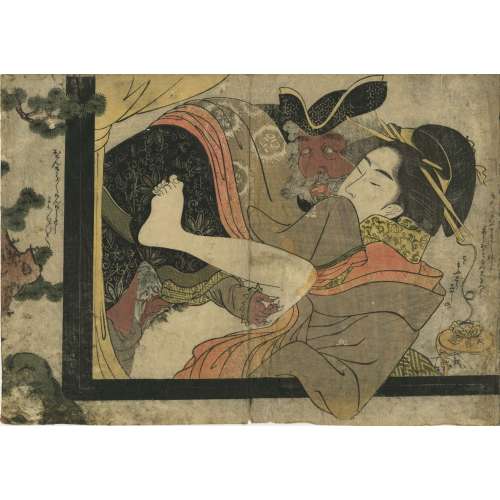 Woodblock print album of thirteen prints, ōban, nishiki-e. Artist: Chōkyōsai Eiri [鳥橋斎 栄里] (Japanese, fl. c. 1789 ~ 1801 ). Models of calligraphy (Fumi no kiyogaki), New Year 1801. This title is taken from Chris Uhlenbeck's Japanese Erotic Fantasies Sexual Imagery of the Edo Period. — Hotei Publishing, 2005, ISBN 90-74822-66-5):. A detailed description of the album can be found at The Complete Ukiyo-e Shunga №9 Eiri, 1996, ISBN 4-309-91019. Most of the edition is in Japanese, though Richard Lane writes a section in English: Eiri: Love-letters, Love Consummated: Fumi-no-kiyogaki. The article starts with the following statement: "Why all the fuss about Sharaku? Because he is so "mysterious"? No, not at all: because he is such a good artist. But Sharaku is not the only great yet enigmatic ukiyo-e artist and I propose to resurrect here one of his important contemporaries who has been all too long neglected: Chōkyōsai Eiri. As with many of the notable ukiyo-e masters, nothing is known of Eiri's biography. All we can say is what we learn from his extant prints and paintings: that he flourished during the second half of the Kansei Period [1789-1801]; and that he was a direct pupil of the great Eishi - who, being of eminent samurai stock, may well have attracted pupils of similar background." Another citation from Japanese Erotic Fantasies: "This album is one of the boldest sets of ōban-size shunga known, The first edition contains thirteen instead of the customary twelve designs". Here I present all thirteen prints, though the edition I bought in Kyoto in 2014 contained only twelve. The thirteenth print was purchased later in the United States (sheet №12).
Woodblock print album of thirteen prints, ōban, nishiki-e. Artist: Chōkyōsai Eiri [鳥橋斎 栄里] (Japanese, fl. c. 1789 ~ 1801 ). Models of calligraphy (Fumi no kiyogaki), New Year 1801. This title is taken from Chris Uhlenbeck's Japanese Erotic Fantasies Sexual Imagery of the Edo Period. — Hotei Publishing, 2005, ISBN 90-74822-66-5):. A detailed description of the album can be found at The Complete Ukiyo-e Shunga №9 Eiri, 1996, ISBN 4-309-91019. Most of the edition is in Japanese, though Richard Lane writes a section in English: Eiri: Love-letters, Love Consummated: Fumi-no-kiyogaki. The article starts with the following statement: "Why all the fuss about Sharaku? Because he is so "mysterious"? No, not at all: because he is such a good artist. But Sharaku is not the only great yet enigmatic ukiyo-e artist and I propose to resurrect here one of his important contemporaries who has been all too long neglected: Chōkyōsai Eiri. As with many of the notable ukiyo-e masters, nothing is known of Eiri's biography. All we can say is what we learn from his extant prints and paintings: that he flourished during the second half of the Kansei Period [1789-1801]; and that he was a direct pupil of the great Eishi - who, being of eminent samurai stock, may well have attracted pupils of similar background." Another citation from Japanese Erotic Fantasies: "This album is one of the boldest sets of ōban-size shunga known, The first edition contains thirteen instead of the customary twelve designs". Here I present all thirteen prints, though the edition I bought in Kyoto in 2014 contained only twelve. The thirteenth print was purchased later in the United States (sheet №12). №1: "...one of the most exotic scenes in all shunga. A Dutch kapitan is discovered coupling with a lovely Japanese courtesan, beside a large window opening upon a garden...".
№1: "...one of the most exotic scenes in all shunga. A Dutch kapitan is discovered coupling with a lovely Japanese courtesan, beside a large window opening upon a garden...".

 №2: "...a fair young harlot is seen masturbating with a grinding-pestle - a man watches intently from under bedding." [I have two specimens of this design; the one from album is more soiled but less faded].
№2: "...a fair young harlot is seen masturbating with a grinding-pestle - a man watches intently from under bedding." [I have two specimens of this design; the one from album is more soiled but less faded].
 №3: "...the artist has effectively contrasted the lovers by depicting the man's face as seen through the geisha's gauze skirt. [...] we are impressed more by strikingly elegant composition, the dramatic coloring, rather than feeling any great urge to participate in the energetic proceedings..."
№3: "...the artist has effectively contrasted the lovers by depicting the man's face as seen through the geisha's gauze skirt. [...] we are impressed more by strikingly elegant composition, the dramatic coloring, rather than feeling any great urge to participate in the energetic proceedings..."
 №4: "This scene is a most straightforward one, featuring the standard Missionary Position [capitalization by R. Lane].; but withal, the contrast of the young and naked, secret lover and the richly-clothed courtesan amid luxurious bedding..."
№4: "This scene is a most straightforward one, featuring the standard Missionary Position [capitalization by R. Lane].; but withal, the contrast of the young and naked, secret lover and the richly-clothed courtesan amid luxurious bedding..."
 №5: "In a striking lesbian scene (which has no equivalent in Utamaro, and is, incidentally, often omitted in later editions of this album), the girl at left prepares to receive the harikata (dildo) worn by the older girl at right (who holds a seashell containing lubricant)."
№5: "In a striking lesbian scene (which has no equivalent in Utamaro, and is, incidentally, often omitted in later editions of this album), the girl at left prepares to receive the harikata (dildo) worn by the older girl at right (who holds a seashell containing lubricant)."
 №6: "In the first appearance of a matronly heroine in this series, we find a widow - with shaven eyebrows and clipped hair - sporting with a handsome yound shop-clerk, mounting him with all her might."
№6: "In the first appearance of a matronly heroine in this series, we find a widow - with shaven eyebrows and clipped hair - sporting with a handsome yound shop-clerk, mounting him with all her might."

 №7: "... lady of samurai court: here, shown taking advantage of an official outing to temple and theatre, to rendezvous with a secret lover on a teahouse balcony." R. Lane considers this design the least successful in the series, especially in comparison with the same theme by Utamaro: "Utamaro female is almost ferocious in her lust for sexual gratification", which does not sound true to me. See Utamaro's sheet №5 from the album Utamakura (歌まくら, Poem of the Pillow) [courtesy The British Museum without permission]:
№7: "... lady of samurai court: here, shown taking advantage of an official outing to temple and theatre, to rendezvous with a secret lover on a teahouse balcony." R. Lane considers this design the least successful in the series, especially in comparison with the same theme by Utamaro: "Utamaro female is almost ferocious in her lust for sexual gratification", which does not sound true to me. See Utamaro's sheet №5 from the album Utamakura (歌まくら, Poem of the Pillow) [courtesy The British Museum without permission]:
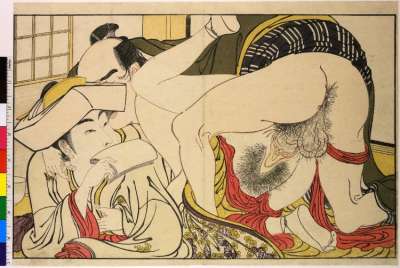 Then, as Richard Lane states, "we are flung suddenly to the bottom rung of Edo society":
Then, as Richard Lane states, "we are flung suddenly to the bottom rung of Edo society":
 №8: "Here we find a fair yotaka ('night-hawk', e.i. streetwalker) accommodating a lusty client in a lumberyard by the bank of the Sumida River".
№8: "Here we find a fair yotaka ('night-hawk', e.i. streetwalker) accommodating a lusty client in a lumberyard by the bank of the Sumida River".
 №9: '... a slightly plump harlot of the lower class receives a night visit from her lover, whose naked form she tries to cover with a cloak."
№9: '... a slightly plump harlot of the lower class receives a night visit from her lover, whose naked form she tries to cover with a cloak."
 №10: "...likely maidservant and lackey - are depicted in bath-room, their passions are all too obviously fired by steaming water."
№10: "...likely maidservant and lackey - are depicted in bath-room, their passions are all too obviously fired by steaming water."
 №11: "...this scene of courtesan and secret lover ranks high not only in Eiri's œuvre but also in the annals of the ukiyo-e genre itself. Both design and colouring are impeccable and, for this period, there is nothing even in the work of great Utamaro that really surpasses it." Again, a doubtful statement, however, this is Utamaro's design for the reader to judge:
№11: "...this scene of courtesan and secret lover ranks high not only in Eiri's œuvre but also in the annals of the ukiyo-e genre itself. Both design and colouring are impeccable and, for this period, there is nothing even in the work of great Utamaro that really surpasses it." Again, a doubtful statement, however, this is Utamaro's design for the reader to judge:
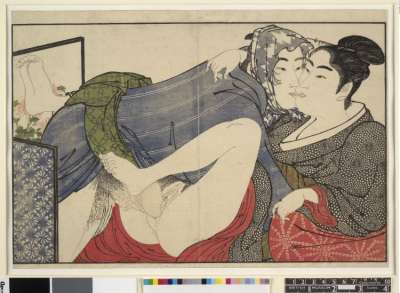 The last design in my album is this:
The last design in my album is this:
 #13: In most reference books it goes under number 13, and we will assign this number to the sheet. "The final scene of the album features naked participants, probably samurai man and wife. The print is rather subdued in tone and colour, if not in the degree of the passion displayed..."
An additional sheet, acquired separately from a reputable dealer in New York, is usually listed as №12:
#13: In most reference books it goes under number 13, and we will assign this number to the sheet. "The final scene of the album features naked participants, probably samurai man and wife. The print is rather subdued in tone and colour, if not in the degree of the passion displayed..."
An additional sheet, acquired separately from a reputable dealer in New York, is usually listed as №12:
 №12: "One might think that Eiri has reached his peak with the preceding plate 11 - and indeed he has, in both esthetic and erotic terms. But the album is not yet finished, and the next scene lends a needed variety to the series, a slightly comic tableau featuring a middle-aged lackey attempting to forcibly seduce a servant girl of the same domicile". Utamaro's design, that inspired Eiri is here:
№12: "One might think that Eiri has reached his peak with the preceding plate 11 - and indeed he has, in both esthetic and erotic terms. But the album is not yet finished, and the next scene lends a needed variety to the series, a slightly comic tableau featuring a middle-aged lackey attempting to forcibly seduce a servant girl of the same domicile". Utamaro's design, that inspired Eiri is here:
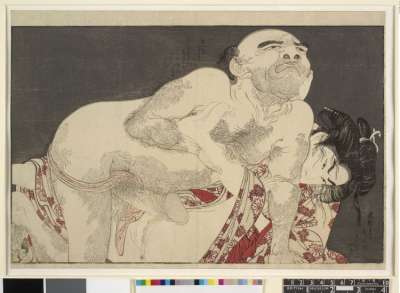 All descriptions are taken from Richard Lane's article at The Complete Ukiyo-e Shunga №9 Eiri, 1996. He concluded: "...Eiri's erotic series represents a major contribution to shunga art towards the close of ukiyo-e "Golden Age". In part inspired by Utamaro's classic album, this series withal constitutes a unified and original achievement, providing a cumulative effect of gracefully elegant yet glowing eroticism, which remains in the mind's eye long after the pictures themselves are far away."
I only would like to mention here that in several reference sources this album goes under name of Eisho; unfortunately, this mistake is reproduced at www.ukiyo-e.org, which miraculously shows exactly my print, but under the wrong name of the artist. The same mistake can be found at Shunga. The art of love in Japan. Tom and Mary Anne Evans. Paddington Press Ltd., 1975. ISBN 0-8467-0066-2; plates 6.74-6.77: Chōkyōsai Eishō, c. 1800. Even the British Museum edition of 2010 gives the same erroneous attribution: Chōkyōsai Eishō (1793-1801); they provide the following translation of title: "Clean Draft of a Letter" [see: Shunga. Erotic art in Japan. Rosina Buckland. The British Museum Press, 2010; pp. 110-112]. To the honour of the British Museum, I must admit that they have corrected themselves in Shunga. Sex and pleasure in Japanese art. Edited by Timothy Clark, et al. Hotei Publishing, 2013. Now, they say Chōkyōsai Eiri (worked c. 1790s-1801); they also provide a new title: "Neat Version of the Love Letter, or Pure Drawings of Female Beauty". I have already mentioned Richard Lane's version of title: "Love-letters, Love Consummated", and Chris Uhlenbeck's "Models of calligraphy". In poorly designed and printed Shunga. Erotic figures in Japanese art. Presented by Gabriele Mandel. Translated by Alison L'Eplattenier. Crescent Books, New York, 1983, the artist is named Shokyosai Eisho (beginning of the 19th century); title provided: "Models of Calligraphy". Correct attribution to Chōkyōsai Eiri also can be found at Poem of the pillow and other stories by Utamaro, Hokusai, Kuniyoshi and other artists of the floating world. Gian Carlo Calza in collaboration with Stefania Piotti. Phaidon Press, 2010; though the title is translated as "Clean Copy of Female Beauty".
All descriptions are taken from Richard Lane's article at The Complete Ukiyo-e Shunga №9 Eiri, 1996. He concluded: "...Eiri's erotic series represents a major contribution to shunga art towards the close of ukiyo-e "Golden Age". In part inspired by Utamaro's classic album, this series withal constitutes a unified and original achievement, providing a cumulative effect of gracefully elegant yet glowing eroticism, which remains in the mind's eye long after the pictures themselves are far away."
I only would like to mention here that in several reference sources this album goes under name of Eisho; unfortunately, this mistake is reproduced at www.ukiyo-e.org, which miraculously shows exactly my print, but under the wrong name of the artist. The same mistake can be found at Shunga. The art of love in Japan. Tom and Mary Anne Evans. Paddington Press Ltd., 1975. ISBN 0-8467-0066-2; plates 6.74-6.77: Chōkyōsai Eishō, c. 1800. Even the British Museum edition of 2010 gives the same erroneous attribution: Chōkyōsai Eishō (1793-1801); they provide the following translation of title: "Clean Draft of a Letter" [see: Shunga. Erotic art in Japan. Rosina Buckland. The British Museum Press, 2010; pp. 110-112]. To the honour of the British Museum, I must admit that they have corrected themselves in Shunga. Sex and pleasure in Japanese art. Edited by Timothy Clark, et al. Hotei Publishing, 2013. Now, they say Chōkyōsai Eiri (worked c. 1790s-1801); they also provide a new title: "Neat Version of the Love Letter, or Pure Drawings of Female Beauty". I have already mentioned Richard Lane's version of title: "Love-letters, Love Consummated", and Chris Uhlenbeck's "Models of calligraphy". In poorly designed and printed Shunga. Erotic figures in Japanese art. Presented by Gabriele Mandel. Translated by Alison L'Eplattenier. Crescent Books, New York, 1983, the artist is named Shokyosai Eisho (beginning of the 19th century); title provided: "Models of Calligraphy". Correct attribution to Chōkyōsai Eiri also can be found at Poem of the pillow and other stories by Utamaro, Hokusai, Kuniyoshi and other artists of the floating world. Gian Carlo Calza in collaboration with Stefania Piotti. Phaidon Press, 2010; though the title is translated as "Clean Copy of Female Beauty".


